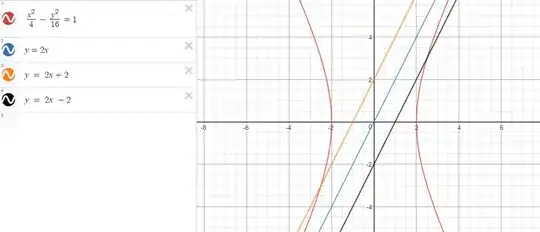A hyperbola has equation $\frac{x^2}{4}-\frac{y^2}{16}=1$. Show that every other line parallel to this asymptote, $y=2x$, intersects the hyperbola exactly once.
So here's the hyperbola. The blue line represents the asymptote $y = 2x$. I am not concerned with the other asymptote that has a negative gradient, $y =-2x$, although the same principles would apply.
Now the problem can re-phrased as:
For the line $y = 2x+c , c \ne 0$
Prove the line intersects the hyperbola once exactly for any non-zero c.
The orange line represents the case where $c>0$.
The black line represents the case where $c<0$.
This is geometrically intuitive, however, I am struggling to prove this algebraically.
FIRST ATTEMPT
First of all, substitute $y = 2x+c$ into $\frac{x^2}{4}-\frac{y^2}{16}=1$ for $y$.
$\frac{x^2}{4}-\frac{(2x+c)^2}{16}=1$
Multiply through by 16.
$4x^2-(2x+c)^2=16$
$4x^2-(4x^2+4cx+c^2)=16$
$-4cx-c^2=16$
$c^2 + 4cx + 16 = 0$
Take the discriminant to determine the number of times the line intersects the hyperbola.
$\Delta = B^2 - 4AC$ for a generic quadratic $Ax^2 + Bx + C = 0$.
(Using upper case $A$, $B$ and $C$ as lower case $c$ is already taken.)
Therefore,
For $0x^2 +4cx + (c^2 + 16)=0$ where the quadratic is taken in terms of $x$.
$\Delta = (4c)^2 -4(0)(c^2 + 16) = 16c^2$
As $c \ne 0$,
$16c^2 > 0$
Hence all lines parallel to $y = 2x$ must intersect the hyperbola twice.
I've managed to disprove what I am trying to prove. Please can someone explain where I have gone wrong.
